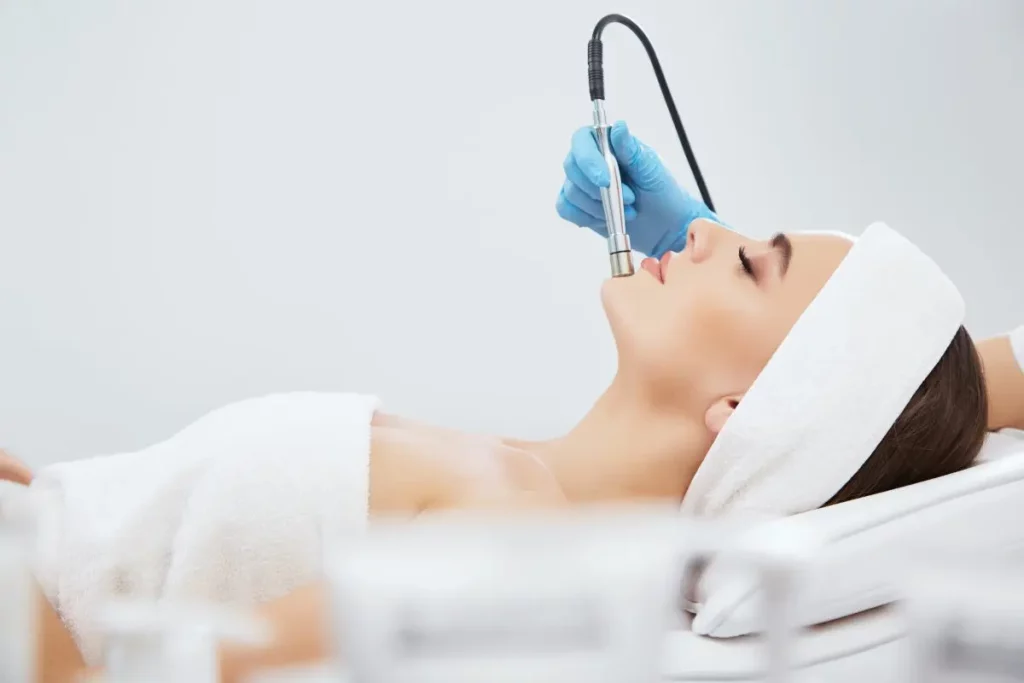at Omniya Clinic in London
Microdermabrasion is helpful for people who have very superficial acne scars, pick marks, acne discolouration, mild acne, sallow skin, and dull skin. This may be a good treatment option for anyone who has superficial skin issues and busy lifestyles and they are looking for a treatment that offers a number of benefits with virtually no downtime or side effects. People with deeper acne scars will typically have to have a number of microdermabrasion treatments. We also offer a number of other skin treatments, and so it may be that our skin specialist recommends some other options. Ultimately, though, the choice is, of course, yours.

Microdermabrasion treatment can help with a range of skin issues.
These include:
A lot of people find microdermabrasion helpful if they have active acne. It can also be beneficial for raised acne scars, very superficial acne scars, pick marks, and mild acne discolouration. This treatment is widely used for unclogging pores and clearing acne. Often used in combination with medical acne extractions and gentle glycolic peels, microdermabrasion can help to speed up acne clearing.
Many patients have also turned to microdermabrasion for melasma. It can be helpful in treating this condition, as well as other forms of hyperpigmentation. Optimal melasma treatment may typically include monthly or bi-weekly microdermabrasion used in combination with medical acne extractions and gentle glycolic peels, microdermabrasion can help to speed up acne clearing. Combined with fading creams, daily sunscreens, and glycolic peels.After your initial consultation, you can proceed with the treatment, or take some time to consider it. In most cases, we will have allocated enough time for the treatment to be carried out on the same day, should you so wish.
Most of product contain local anesthetic but some don’t. A numbing cream can be applied before to improve the comfort during the injection. The procedure takes between 15 and 30 minutes depending on which areas are treated. A massage of the area will be performed to make sure the product is well placed.
Microdermabrasion is a procedure that is minimally invasive. It does not involve any type of surgery, and so you’re not going to need to do a lot to prepare for it. However, we do pride ourselves on offering a thorough consultation before every treatment. This gives us the ability to discuss your skin concerns with you. We will also ask about any medical conditions, allergies, and past cosmetic procedures. This will help us to understand what sort of treatment is going to be right for you. This is also a great opportunity for you to ask any questions that you may have.
Before you have your treatment, we would recommend avoiding waxing, tanning creams, and sun exposure a week beforehand. It is also important to avoid using any masks or exfoliating creams three days before your treatment. Before the procedure begins, you will need to remove any makeup and cleanse your face.
This is a treatment that can be done as often as weekly or up to every eight weeks. This will depend on the tolerance of your skin and the desired cosmetic outcome. A lot of people opt to begin with weekly treatments for three sessions. They will then change to a monthly maintenance regime. A lot like brushing your teeth, microdermabrasion will help to remove skin debris in a gentle manner. Because human skin tends to regenerate at 30-day intervals, skin improvement with microdermabrasion is not permanent. Therefore, it must be repeated at an average interval of two to four weeks for continual improvement. Typically, numerous treatments – between six and 12 sessions – are recommended for considerable improvement. Of course, this is something that you will be able to discuss with your skin consultant when you have a consultation with them.
Once you have had microdermabrasion, you will be able to go back to your daily activities right away. This is because there is no downtime with this treatment. You should, however, make sure you use gentle skin care products and keep your skin hydrated. Do not use any topical acne treatments for at least one day after your treatment. It is also vital to make sure you use sunscreen to protect your skin, no matter what time of year it is. After all, even though it is still cold, the sun does shine in winter, and your skin is going to be more sensitive to sun in the few weeks that follow the treatment.
Most people do not experience any side effects when it comes to microdermabrasion. You may feel a bit of skin irritation and tightness. However, most people find that they are able to go straight back to their usual daily activities.
Some of the side effects that are possible include: